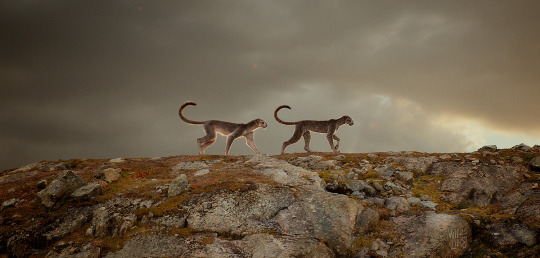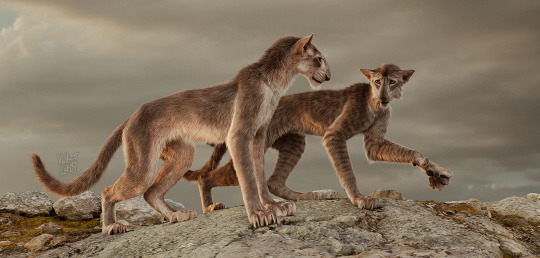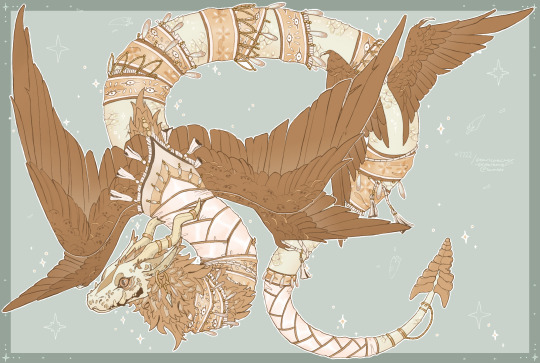#creature art
Explore tagged Tumblr posts
Text

kaiju
#you ever draw a fish for something else and then that falls through so u just have a fish drawing u need to repurpose#yeah#anyway#art#artwork#digital art#digital drawing#artists on tumblr#illustration#digital aritst#artist#omatoxin#surrealism#my art#drawings#monatoxin#coelacanth#kaiju#monster#creature art#monster art
2K notes
·
View notes
Text




Some more 3D renders, this time with two Koties (fantasy felines from my personal lore/story). These are random characters made on the same Northern Kotie model, but I tried to give them some personality. I posted one of them recently and here he got a striped friend. It's open to interpretation what their story is, what they're looking for, and what they're talking about ~
Made in Blender. The landscape model from Fab.
#art#3D#3D model#3D render#blender#blender3d#creature art#fictional species#original species#feline#realistic#kotie#koties#villiedoom
671 notes
·
View notes
Text






Phoenix art doll
Sold
Repeat of the phoenix I made last year, but this one got bigger wings and tail.
349 notes
·
View notes
Text

For StaticJack on Toyhouse!
#finished#digital#portrait#digital art#furry#creature#monster#teeth#dragon#fantasy#illustration#digital drawing#anthro art#anthro artist#creature art#procreate
283 notes
·
View notes
Text




All 4 galaxy creatures for @omniiac!✨☄️🪐 Was absolutely fun to come up with these designs!
#digital art#art#digital illustration#aesthetic#concept art#digital drawing#creature#fantasy#artwork#illustration#whale#ocean#sea#blue#sea creatures#creature art#creature design#monster#monster design#fantasy creature#creature concept#stars#cosmic#galaxy#wings#fantasy art#background#colorful#turtle#squid
203 notes
·
View notes
Text

Who knew living in the Roman Emperor's toilet would make you grow big and strong?
Mediterranean Freshwater Crab (Potamon fluviatile) AKA Qabru (Maltese)
Italy, Malta, the Balkan Peninsula
Status: Vulnerable
---
A population of particularly large crabs lives under the Trajan Forum in Rome.
#crab#crustacean#arthropod#invertebrate#crab art#inverts#creature art#europe#italy#greece#malta#montenegro#croatia#macedonia#albania
68 notes
·
View notes
Text

Seeking Resplendence
#my art#dragons#astronomy#space#digital art#dragonposting#art#artists on tumblr#drawing#illustration#fantasy#celestial creatures#dragon art#creature art#stars#wyvern
55 notes
·
View notes
Text

The Deadly Nadder!!
I wanted it to look like it was raising a craniofacial hinge, so I hope that translated!
#httyd#how to train your dragon#httyd fanart#httyd fandom#how to train your dragon fanart#deadly nadder#creature design#dragon#digital art#creature art#my art
56 notes
·
View notes
Text

I’m really enjoying making these creature thingies. I might make more. I might not. We’ll see
46 notes
·
View notes
Text

Fence lizard inspired dragon (wip) 🦎
#art#drawing#creature design#dragon#monster art#creature art#dragon drawing#dragon art#digital art#fantasy art
35 notes
·
View notes
Text

A character I've been meaning to give a ref since I got her. Very glad I did it now because I'm in love with the flowers draping over her wings <333
#art#artwork#drawing#my art#oc#original character#artists on tumblr#digital art#procreate#dragon design#dragon art#creature art#dragon oc#character design#character art#character sheet#my characters#original characters#oc artwork#oc art#my ocs#ocs
25 notes
·
View notes
Text

maferzin ᛜ amphithere ᛜ queen of the roost
she ! the bean ! the long noodle ! I keep referring to her as the spaghetti project, so thankful to have it done after all the chaos this month q wq
Lore rambles about the amphitheres / roost under the cut to keep things tidy
Amphitheres. Noisy, multi-winged beasts that flocked in the remains of a Harpy outpost after the lich's fall due to a surplus of energy there, choosing to leech directly from the corrupted magics to fuel their flock rather than worry of possible risks as the benefits far outweigh any possible negatives. They have a drive for survival and know that they do so better in numbers, which requires above all protection, sustenance, and a strong sense of community between the flock. They're smart, but they're... not smart. While they can understand difficult concepts and engage in philosophy, a lot of the time they'd just rather.... not. In general, Roost Amphitheres tend to find more joy in the more 'stupid' aspects in life: unironically engaging in the equivalent to 'meme culture' in their little community.
Unironically, these little pea-brained idiots name themselves after whatever little thing makes them giggle the most so that they get to hear it time and time again and share that experience with friends. As amphitheres depends on identifying each other via scent patterns, the name is as much an accessory to them as the garb they wrap themselves in. There are some Amphitheres who may change their name once a week, others that simply end up finding something that feels right to them and staying with it their whole lives.
( Fun fact: most of the Roost Amphitheres are named after parts of the dubbed nanalan show because it tickles my brain so much! Maferzin, Peepo, and Nasa are all ones that have survived the name cycle over the years to keep to this homage! )
They are quick to react and slow to forgive, making them risky allies for many reasons. It's not uncommon for them to end up scrapping with dragonkin over veiled insults towards their nonsense habits or their more beast-like mannerisms when feeding / playing / existing in general, which has made creating long-lasting allies a hardship. In recent years, researchers from the main allied outpost have tried to gain access to Roost grounds to survey the lich's remains and form diplomatic bonds with the Amphitheres under Spire's guidance, which has been... mostly successful. There's been a glut of magic from the lich this season as his corpse will take aeons to properly decay, leaving the Amphitheres full to glut on his magic, jolly, and generally more amicable.
Physiologically, amphitheres are serpentine creatures that have bodies covered with scale and fur, and have no proper 'limbs' beyond wings. Six tends to be the norm, but some have been recorded with more or less depending on their heritage and how heavily the corruption has settled through their bloodline. 'Maneuvering' wing limbs usually have a singular or pair of clawed digits to allow them to grip or climb, whereas their main 'flying' wings are relatively normal. Some breeds may even fold up maneuvering wings for ease of flying depending on how poorly laid out they are. Two horns is the norm, but four have been recorded. Some may grind off their horns entirely if they get in the way of flying or entangled too much, it's also not uncommon for some to be broken from brawling.
Maferzin is the head of the roost, Queen of the Amphithere flock and considers herself to be quite the catch. She's large for an amphithere, but still dwarfed in comparison to Spire- something that goes to his favour as she's not used to feeling small and dainty around other dragons. As matriarch, her bloodline has cemented itself through the Roost's lineage, having multiple offspring thriving within their flock now, some expecting clutches of their own. She is a good leader in making the right call for her people, but not always the most empathetic to the struggles of others. She is a deep romantic at heart though and has found peace with the plentiful season in being able to simply thrive and enjoy the finer things in life: good company, a plentiful den, the newest in allied clan garb from the neighbouring silk trader....
She's never been one for frivolities, but with the new trade agreements and allies have come gifts. This has been a new pleasure she's very much enjoyed: thoroughly dressing both herself and her kin up in whichever finery the neighbouring seamstress sends their way ( she's honestly just thrilled to have a new body shape / flight pattern to clothe!! ) She has learned to keep whichever poorly-shaped pearls around her midsection, as they're the ones most likely to be pulled as she scales and winds herself around things.
While the species is jovial now, when starved... things change. They will attack anything that moves and wipe out entire ecosystems if left to their own unchecked. They are nasty buggers to fight as many of them tend to be venomous and they are always in large numbers. When alerted, many of them will create noise to pass on the alarm to neighbouring Amphitheres, usually in the form of hissing or rattling of tails ( for those who have rattles. ) Having them be peaceful long-term is a beneficial goal for everyone, as their existence allows plentiful research on lichfall from the main outpost, and having them be calm allows safe trade routes through their domain for other outposts. As such, the main outpost has devised a back up plan for if things do fall into a bad season via a storage system of liquid ley via the elementals at the oasis.
It's a delicate balance keeping it all afloat, but they're all somehow bound by the lich's fall and need to support themselves somehow.
Also, the base sketch of this was from literal years ago but I've been crying for the energy to actually tackle it. Feeling very good about being able to do so now!
#hex scribbols once again#fr art#fr fanart#creature art#dragon art#fr spiral#fr art share#flightrising#flight rising#digital art#dragon#spiral dragon
23 notes
·
View notes
Text

NOCTIS x OBASI DOODLE DUMP
( both characters are butch lesbians, she/he! )
hello noctasi nation i bring MORE FOOD
just fun character exploration sketches that i compiled into one sketch page. i’m trying to improve with dynamic poses but especially building confidence with sharing my sketches. i’m so used to just sharing finalized pieces that i tend to just keep my sketches for myself and for my portfolio.
i really love doing sketch dumps like this so here’s to trying to work on more! :D
#sketch dumps are so nice bc i can just turn my brain off and let the vibes guide me#noctasi#noctis x obasi#obasi x noctis#monstatrons art#blade in the city series#monster art#monster#creature#creature art#original character#oc#sketch#lesbian#butch lesbian#butch4butch#anthro art#anthro#furry#furry art#ape oc#ape art#oc artwork#oc art#gorilla#gorilla oc
20 notes
·
View notes
Text


I like them lots💚
#art#digital art#my art#eelz artz#fanart#my artwork#character design#creature design#minecraft#mc#minecraft art#mineblr#minecraft fanart#minecraft warden#the warden#warden minecraft#creaking#Minecraft creaking#artists on tumblr#creature art#minecraft headcanons
17K notes
·
View notes
Text

For StaticJack on Toyhouse!
#finished#digital#digital art#portrait#dragon#creature#crocodilian#furry#furry art#creature art#photoshop
196 notes
·
View notes